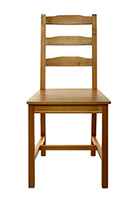With the pandemic and social distancing, getting a slot at the gym can be difficult or worse, gyms may have to close. Our Senior Physiotherapist from Sengkang Community Hospital (SKCH) shares how to turn common household items into exercise equipment.
Do you find it difficult to exercise properly without gym equipment? Senior Physiotherapist Chitra D/O Chandran from
Sengkang Community Hospital (SKCH) shares a simple solution. SKCH is managed by
SingHealth Community Hospitals (SCH), a member of the
SingHealth group.
“You can exercise at home, plus you don’t need sophisticated equipment to keep fit,” Chitra explains, “Commonly-found household items can easily serve as good alternatives to gym equipment such as dumbbells and weights.” These include:
 1. Filled water bottles
1. Filled water bottles
Filled water bottles make great dumbbells! You can start with smaller 500ml bottles before moving on to 1L or 1.5L bottles. You can also reuse soap bottles or juice cartons - make sure to wash them cleanly first!
Suggested exercises: Bicep curls, lunges
 2. Towels
2. Towels
Dry towels are a great addition to helping you stretch out before/after an exercise. To add a challenge, you could use a damp towel too – but remember to wring out all the water first!
Suggested exercises: Loop a towel around your arm or leg when stretching
 3. Rice / flour bags
3. Rice / flour bags
Coming pre-packed, these heavier sacks are easy to grip on to and work great for overhead weight-lifting exercises, squats, and even planks. Larger rice bags can go up to 5kg and 10kg, providing a good challenge.
Suggested exercises: Squats, weight-lifting
 4. Chairs / boxes
4. Chairs / boxes
A sturdy chair or weighted storage box can help to provide an incline for planks, push-ups, tricep-dips, and more! Experiment with different heights to challenge yourself. Chairs also provide a good grip for balancing or chair-based exercises.
Suggested exercises: Inclined planks, step up/step down exercises
As a complement, Chitra also recommends getting
at least 150 minutes of moderate-intensity aerobic activity or 75 minutes of vigorous aerobic activity per week.
“Break it up into multiple sessions, like 20 to 30 minutes daily. Some physical activity is better than none, and can help offset some of the risks of being sedentary, like high blood pressure (hypertension).”
Ref: K21
Check out other articles on exercising at home:
Exercise at Home: Workouts for All Ages and Fitness Levels
Tips to Exercise Safely at Home
How to Exercise Effectively at Home
The 10-minute Morning Workout
